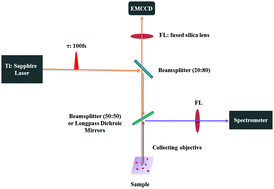Enhanced second harmonic generation in individual barium titanate nanoparticles driven by Mie resonances†
Abstract
Although previous designs of nonlinear optical (NLO) nanostructures have focused on photonic crystals and metal plasmonic nanostructures, complex structures, large ohmic loss, and Joule heating greatly hinder their practical applications. Beyond photonic crystals and metal plasmonic nanostructures, all-dielectric materials (ADMs) offer new ways to generate NLO behavior at subwavelength scales. Herein, we report enhancement in the tunable second harmonic generation (SHG) reflected from individual mid-refractive ADM nanoparticles, BaTiO3 nanoparticles (BTO NPs). Multipole decomposition, as observed in the linear spectra, demonstrated that the SHG enhancement originated from an overlap between the magnetic dipole or quadrupole resonance and the second harmonic wavelength of the pump source. In the vicinity of magnetic resonances, the localized field inside the nanoparticles could be increased by more than one order of magnitude. Compared with the spectral-separated electric and magnetic resonances in high-refractive all-dielectric nanostructures, an overlap of resonances was observed in the mid-refractive all-dielectric nanostructures and it resulted in electromagnetic (EM) mode coupling. A broad spectral characteristic results in moderate EM field enhancements over a wide wavelength range, which is conducive to the tunability of the SHG responses. Our study revealed the relationship between the linear and nonlinear optics at the nanoscale and helped in the design of efficient nonlinear optical devices based on ADMs.



 Please wait while we load your content...
Please wait while we load your content...